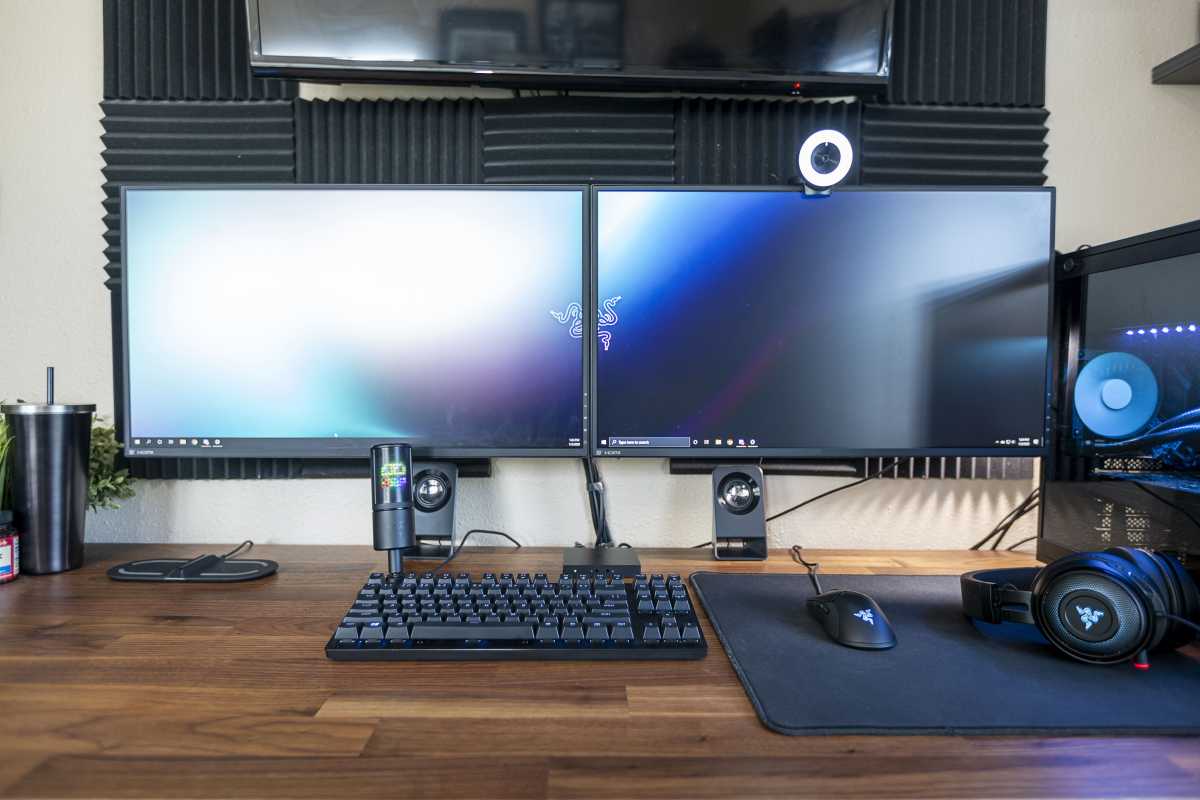Streaming has become extremely accessible over the past few years. With major personalities like Ninja and Dr. Disrepect inspiring their viewers and the medium picking up steam overall, many more people have been trying to enter the streaming game. The same can be said for peripheral manufacturers. Razer has one of the more well-rounded streaming ecosystems and we wanted to see what it was like streaming with it.
For the purpose of clarity, this review will go over the broader experience of setting up and streaming with Razer’s gear before going into specific detail regarding each individual piece of equipment.
The overall experience
Over the past few years, streaming has become relatively accessible for those willing to make an investment in some beginner gear. Since the medium has grown exponentially in a short window of time, the demand for more options has increased across the board. Razer’s streaming offerings are a well thought-out combination of devices that exude accessibility when paired together. The Razer setup is as close to plug-and-play as possible when it comes to streaming gear, albeit with some glaring software issues.
Our streaming setup was comprised of Razer’s proprietary capture card, the Ripsaw HD, Seiren Emote, Kiyo webcam, Kraken V2 Ultimate headset, Viper lightweight mouse, and Huntsman TE keyboard. Heading into this review we didn’t really know what to expect from Razer. The company had a rock-solid 2019 and entered 2020 looking for a repeat, so our expectations ran high.
Razer brings something interesting to its streaming setup in the sense that literally everything at the user’s desk can be unified through Synapse and its accompanying apps—but more on that later. While any company’s software is generally the bane of most gamer’s existence, it actually helps provide a sense of ease when dialing everything in before spinning up the stream. It’s not that setting up a stream with a setup comprised of various company’s gear is overly difficult, but there’s a definite sense of confidence knowing that everything can be found in one place. There were definite drawbacks when using the Synapse suite but overall, it’s nice to have everything in one place, especially when things go south.
Setting up the Ripsaw HD was near effortless. We’ve worked with other external capture cards in the past but what really seemed out of place was that the software we had to install was unintrusive. Because we already had Synapse installed, the Streamer Companion app took no time and didn’t add an extra icon to our overcrowded desktop. It’s a small but weirdly noticeable thing to not have to go through an intrusive software install.
Razer’s Kiyo webcam was an interesting device to test out since it comes with an intuitively designed ring light. Controlling the ring light is extremely easy and allows the user to tweak their image on the fly, which is something you might be doing a lot with the Kiyo since it seems a bit more sensitive than other webcams out there. Our streams looked fairly solid, although a bit grainy running 720p at 60fps. Weirdly enough, Synapse just randomly decided that it didn’t like the Kiyo and stopped registering the video. This definitely breaks the cohesion we talked about since we had to rely on tweaking video settings in OBS instead of Synapse.
The Seiren Emote microphone was charming but was perhaps the most tedious to setup. It wasn’t difficult because it was hard to navigate the software, but rather, because the microphone just didn’t want to install properly. After uninstalling and re-installing the entire Synapse suite twice, it finally started working and was extremely easy to set our emotes.
Unfortunately, the Kiyo has a lot of difficulty picking up the Seiren Emote’s display and therefore the Seiren Emote didn’t really add anything to the stream. We ended up taking the microphone off of our arm and using the included base stand since the display wasn’t really showing up. We had to really mess with the lighting to get it to show up on the Kiyo and even when it did, the colors were muted or washed out.
One thing we definitely don’t recommend is using the Seiren Emote with the Huntsman TE. The Huntsman TE tends to make a fair amount of noise and while the Seiren Emote relies on its hypercardioid design to eliminate noise, the Huntsman TE is just too loud. It’s something that some viewers may be able to drown out but the Huntsman TE will definitely be picked up. This is something that can be tweaked in OBS but again, really dismantles that great sense of cohesion.
Overall, Razer’s streaming gear feels just right for beginners when it’s firing on all cylinders and the software is cooperating. There are some definite hiccups that need to be ironed out when it comes to Synapse and its companion apps. Having every piece of hardware within reach in the Synapse software is fantastic but the sense of cohesion is easily broken when one piece of equipment is malfunctioning due to the software.
It’s a love-hate relationship, but there are far more positives to be said about Razer’s streaming ecosystem. The plug-and-play feel of Razer’s streaming gear when it’s all up and running gives off the feeling that Razer very thoughtfully designed these products for the niche space of streaming, despite Synapse working against that concept.
Kiyo webcam
As far as beginner webcams go, there’s really nothing better than the Kiyo. Upon first glance, the Kiyo seemed a bit gimmicky but we warmed up to it rather quickly. While this ambitious camera has its flaws, it is still extremely well-suited for beginners.
When someone looks at the Kiyo the absolute first thing that they will notice is the ring light, which may be why it seems so gimmicky at face value. However, the ring light is actually a huge asset to the Kiyo and allows it to be more flexible than some of its competitors. The Kiyo seems to be a bit more sensitive to light than other webcams, which can make it a bit frustrating to work with, especially with the Seiren Emote microphone.
Working with the Serien Emote was a non-starter, as the Kiyo couldn’t reliably pick up the Emotes extremely charming display. To us, it seemed as though the two products were marketed towards two different audiences, beginners and those who have invested in a pricier camera cable of picking up the Emote with ease.
As always, the software is what drags the Kiyo down a bit. Synapse is often the lesser of the evils when it comes to peripheral software but this time around it was actually frustrating to use at times. Synapse just decided one day that it would no longer recognize the Kiyo and therefore we had to switch over all of our settings to OBS. It isn’t a deal-breaker and some users might prefer this avenue but we really enjoyed the cohesion of using an all Razer streaming setup.
Aside from a bit of graininess on stream, the Kiyo performed well while running 720p at 30fps. The quality isn’t going to set the world on fire, and nor should it at this price point. While $99.99 isn’t “cheap,” it isn’t enough to dock the Kiyo for a bit of graininess. Other competitors tend to suffer from the same pitfalls and it’s nothing to really write home when it comes to beginner level products like the Kiyo. Where the Kiyo might outperform other webcams is how well it picks up in dark rooms. While the image quality is better in the dark than some competitors, this is by no means a feasible way to stream.
The Razer Kiyo is a solid option for those looking to invest in a streaming setup. While the webcam feels at its best when paired with other Razer products, it may not match up with some Razer streaming products like the Seiren Emote. The Kiyo’s intuitively designed ring light is a great touch that extends beyond the gimmicky and into the realm of practicality. While we really did enjoy the Kiyo, we’d be remiss if we didn’t caution that the Synapse software doesn’t always play nice with it and we did have some issues with Synapse locking us out of the Kiyo’s settings. Aside from the software issues, the Kiyo is a great option for beginners.
Ripsaw HD
Perhaps the most important part of any streaming setup is the capture card. There are a decent amount of choices out there for capture cards and most of them are absolutely solid performers but at a slight premium. Razer has given prospective streamers the closest thing to a plug-and-play capture card as possible, it also doesn’t hurt that it looks good, too.
When we first unboxed the Ripsaw, we were surprised by just how good it looks. There isn’t anything aesthetically wrong with other external capture cards but the Ripsaw feels right at home amidst some of the more “high-end” peripherals we have on our desks. This is also arguably the least important part of the Ripsaw’s allure.
All the usual streaming necessities are here. Two HDMI ports, one in and one out, a USB-C to A connection, and two 3.5 millimeter audio jacks for input and output. The Ripsaw HD is capable of full HD 1080p at 60fps and allows for 4K 60fps passthrough for those who game at a higher resolution. The Ripsaw also comes loaded with audio mixing capability, though, we normally opt to adjust in OBS. Overall, there’s a decent amount of features here that are pretty standard for the industry right now.
The setup here is a breeze and if the user already has the Synapse software installed, then the process is even less intrusive. Other external capture cards were easy enough to install and their software was pretty unintrusive as well but having the Ripsaw in the same place as our other Razer products we were testing added to the unity of our streaming setup.
There’s really not too much else to say except that this was a solid workhorse when it came to streaming and it really never faltered. Setting up in OBS was a piece of cake and it felt right straight out of the box. The ease of access here is sure to lure in beginner streamers but the price point may be a bit of a turnoff. The Ripsaw handles well in all the right ways and it undercuts some of the major competition by a few bucks. Beginners, or anyone for that matter, would do well with the Razer Ripsaw HD as it is about as hassle-free as it gets when it comes to streaming. Seriously, this is the one.
Seiren Emote
In one of the more “unnecessary” but totally awesome moves Razer has made in recent history, the Seiren Emote microphone is pretty out there. The audience here is clear and the execution is solid across the board. Razer has blended an entertainment product with a staple peripheral for one of the coolest streaming products around. Hell, it even sounds stellar, too.
Razer’s Seiren Emote is a decisively streamer oriented product. There’s no real reason anyone else should buy this microphone. This doesn’t mean that the Seiren Emote is a bad microphone, it just means that users who don’t stream won’t be getting anything out of what they paid for, which is a charming 8-bit Emoticon LED display.
Setting up the Seiren Emote is pretty simple if the user is familiar with Synapse and its accompanying applications but it can quickly get annoying to shift in and out of giving the Streamer Companion App control. The only way the Seiren Emote will properly function is through the Streamer Companion App and it just seems that the app should be rolled into the Synapse base software. We spoke before about having to uninstall and reinstall Synapse in order to get the Serien Emote working properly and it was properly frustrating in that regard. Once everything was ironed out with the software things became much more enjoyable when programming our desired emoticons.
Quality here is pretty solid and we were pleasantly surprised with how our voices came through on stream. Despite being of Hypercardioid design, this microphone picks up a bit more background sound than we would have liked. The Seiren Emote is going to pretty clearly pick up ever click, clack, and thock of your keyboard no matter how far away or close it is, especially with the Huntsman TE. Seriously, don’t use the Huntsman TE with this microphone, it’s super loud on stream compared to other keyboards.
The Seiren Emote is a bit of an anomaly in the sense that it is an extension of an on-stream alert that more dynamically communicates with viewers on the streamer’s behalf. It’s neat but ultimately unnecessary for beginners and shouldn’t really be paired with the Razer Kiyo since the webcam has some difficulty picking up the 8-bit LED display that makes the Serien Emote worthwhile.
Kraken Ultimate
Buying a headset has basically devolved into a two qualification decision—is it comfortable and does it have surround sound? These questions used to be pretty clear cut but with high-end audio making a play for the gaming industry, things are beginning to get a bit more complicated out there when it comes to choosing the right headset. Razer’s Kraken Ultimate headset is a strong addition to any setup in general due to the THX Spatial Audio but it may also add a bit of extra flair to a stream if that’s the user’s prerogative.
Starting off with the nitty-gritty, the Kraken Ultimate uses a USB connection and boasts THX Spatial Audio, 50-millimeter drivers, an extendable active noise-canceling microphone, gel ear cushions, and Razer’s Chroma lighting. If that sounds like a lot, it’s because it is, in fact, a lot, but the standout feature here is the THX Spatial Audio.
Every headset within range of the Kraken Ultimate is going to have some sort of digital surround sound but the THX Spatial Audio feels rather intense in this instance. The surround sound here ensures that you accurately here where an enemy player is located and helps to immerse the user in their game of choice.
THX audio can be turned on and off via the on-headset controls that are easy enough to reach and differentiate between. Users will also find a volume wheel just under the THX toggle. We never really used these controls since they were a bit out of sight out of mind.
Conversely, we used the microphone’s click-to-mute function a lot and it always felt awkward. While it’s neat that the red LED at the tip of the microphone indicates when the mic is muted or not, it was always a bit odd to mute the microphone by touching it. We were always a bit worried that our squad would hear the click or the noise. Nobody in our server complained of an audible noise but Discord did pick up the noise. It’s an odd design choice that is easily overlooked when considering how solid the active noise-cancellation is on the Kraken Ultimate.
Active noise-cancellation is probably one of our most beloved features to find on a headset. In our opinion, this should be included on every headset that ships in 2020, in the same way, every keyboard should have a USB-C connection. There really doesn’t seem to be a good excuse for a headset that ships without it at this point. Luckily, the Kraken Ultimate has solid noise cancellation that is accessible through Synapse, along with some other mixing controls that music lovers will for sure want to check out. Bass Boost hits pretty hard and might have you weak in the knees compared to other headsets out there.
The Kraken Ultimate boasts some seriously comfy earcups and while the cooling gel seemed like marketing talk at first, Razer backs it up with some reliably comfortable earcups that keep the temperatures down a bit more than most. There’s a good amount of give to the earcups and that really works in the headsets favor since it isn’t the lightest headset around.
To top it off, the Chroma RGB lighting effects can make for some fun on-stream color. We’re a bit boring around these parts and went for a clean monochromatic theme to our lighting but there are more than enough possibilities here to add some flair to a stream. For our purposes, the lighting wasn’t really necessary, but for others who are more entertainment minded, the Chroma RGB capability will suit them well.
Bottom line, at $129.99, the Kraken Ultimate will be a well-rounded performer not just for streaming and gaming but for any other type of media the user is into, especially music listening. One minor nitpick to close out on is that a detachable cable is another one of those features that are a must heading into 2020. It just adds so much more flexibility to the headset.
Overall, our time spent with Razer’s streaming ecosystem was a very positive experience. We can see that Razer is keen on supporting the streaming scene at every level, although, some products don’t seem geared towards beginners. For example, the Seiren Emote didn’t look too hot while using the Kiyo. While both the Kiyo and the Seiren are solid products on their own, they don’t seem like a good fit for each other since the Kiyo has a really hard time picking up the Seiren Emote, making the Kiyo seem a bit more like an entry-level streaming product.
The Synapse software is also a bit of a love-hate relationship for us considering that it helped just about as much as it hindered. Having all of our streaming gear located in one program was a great comfort. But then came the Streamer Companion App needing to control everything and it all just felt like overcomplicated. It could all have instead been rolled into one app instead of a disjointed suite. There’s also the issue of having to uninstall and reinstall Synapse due to a weird bug where the Seiren Emote wouldn’t install properly. It just felt rough around the edges at times and may prove more frustrating for users who already have a hard time with additional software.
Aside from the one major software issue, we found ourselves setting each piece of equipment up with ease. The Ripsaw HD is by far the easiest time we’ve had setting up a capture card and the Kraken Ultimate headset is a solid headset that sounds pretty great out of the box but has enough customization to serve any form of media.
Razer will likely look to make updates to some of these products and the Synapse software in the near future and we’re excited to see what pops up next in the company’s streaming lineup.
For reviews of the Huntsman TE keyboard and the Razer Viper mouse that were used during the review process, please visit the corresponding links.





